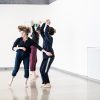I have just returned back to London from the Lake District where (Re)Make, my new project, was in residency as part of its development.
(Re)Make explores making as a way of understanding. I am reminded of the idea that making is knowledge (Ingold, 2013). It is in the doing that understanding starts to emerge. For me, it is in reflection back on the doing that informs and becomes knowledge. Therefore, my first blog post about this project begins with a productive form of not-yet-knowing and stems from a curiosity in remaking as an idea and one I want to explore with other mature cohorts, specifically female dance artist over 40.
I am working with four highly-recognized London-based dance artists who are actively making and performing work. Henrietta Hale, Lauren Potter, Rahel Vonmoos have joined me along with filmmaker Camilla Robinson of Dapper films and Louisa Borg-Constanzi Potts, Creative Producer. The project is funded by Arts Council England and in partnership with Lakeland Arts.
One of the outputs from the residency will be an installation centered around a dance film work that will be open to the public for one year.
This project landed at a time when I was having one-to-one conversations with about a dozen female dance artists in London about making and performing at this point in our careers. (Re)Make is a chance for me to invite three of those dance artists into my practice and to invite in our individual and collective experiences and expertise as contributor to and agitators of understandings and assumptions on making…danc(e)ing.
Having worked with Camilla as part of the Experience and Value of Live Art Project at Tate Modern in 2014 I knew I wanted to invite her to collaborate with me on this new project. We both are interested in approaches to making and in discovering ways of working across diverse fields of practice. For (Re)Make Camilla is revisiting older technologies from her early days as a filmmaker, including shooting on VHS tape. I am revisiting former choreographic strategies and dance works. In doing so it has become apparent the influences of key mentors along my training as a dancer and choreographer, including choreographer and filmmaker Yvonne Rainer, urbanist Ed Soja and educator Vicki Blaine (The Ohio State University Department of Dance).
As part of this residency we openly explore the theme of remaking. As this is a practical process the making is entwined with unmaking and remaking. These, in a sense cannot be separated but work as a triangular give and take.
I make, remake, and unmake my concept’s along a moving horizon from an always decentered centre, from an always displaced periphery which repeats and differentiates them” (Deleuze, 1994)
This quote frees up my need to understand my own making or remaking and allows for a wide field of play between varying aspects of the making process. I might not claim, then, to make something “new” per se but, rather, that I am always working along a spectrum of unmaking, making, remaking that repeats itself over and over again within my practice and across time. Which brings me to the question:
What is contemporary?
and
How might we flirt with other ideas of contemporary dance in this moment?
As part of the residency we are exploring minimal, post-modern movement practices (walking, gesture, scores for improv, etc) as a base form juxtaposed with punctuated moments of more expressive, dynamic, syncronized movements in order to challenge our comfort zones as contemporary dancers and artists. We are exploring improvisation alongside set movement; Dancing in silence and counting to music as a way of making.
In the book, The Body Ecclectic: Evolving Practices in Dance Training by Melanie Bales & Rebecca Nettl-Fiol, also two of my former teachers,
In the chasm created between codified-technique-learned-then-performed and movement-improvised-in-response-to-the-environment lie so many unmentioned approaches and projects that relate if not completely then partially.
These “unmentioned approaches and projects” are what are of interest to me. In order to uncover them in my own practice I must first play on the edges of two extremes in order to find what lies between them. Only then can I discover how they are related or not. A suggestion of playing along a spectrum of choices is in the book and it asks:
What about using Cunningham vocabulary, or some improvised variant thereof, in a non-Cunningham piece? What about intuitively inserting a phrase from Giselle into a solo improvised dance? (2008:34)
I am aware that the above was tried out in the era of Judson Dance Theatre, in the late 1960s and 70s. And what those dancers of that time did has highly influenced the way contemporary dance has evolved. Yet, I am interested to dig a little deeper and to ask:
“What if we made a dance phrase informed by Gene Kelley’s “Singing in the Rain” and then inserted that into a walking improvisation?”
I am wanting to stretch the space between juxtaposing elements and, in that way, challenge us – as contemporary dancers – to try on varying degrees of contemporaneous dancing. Is Gene Kelly and dancing to music contemporary? Is walking in silence as a form of dancing still contemporary?
I very much look forward to returning to Cumbria next week for our second residency. More to come here….
*photo by Roswitha Chesher

Leave a Reply
You must be logged in to post a comment.